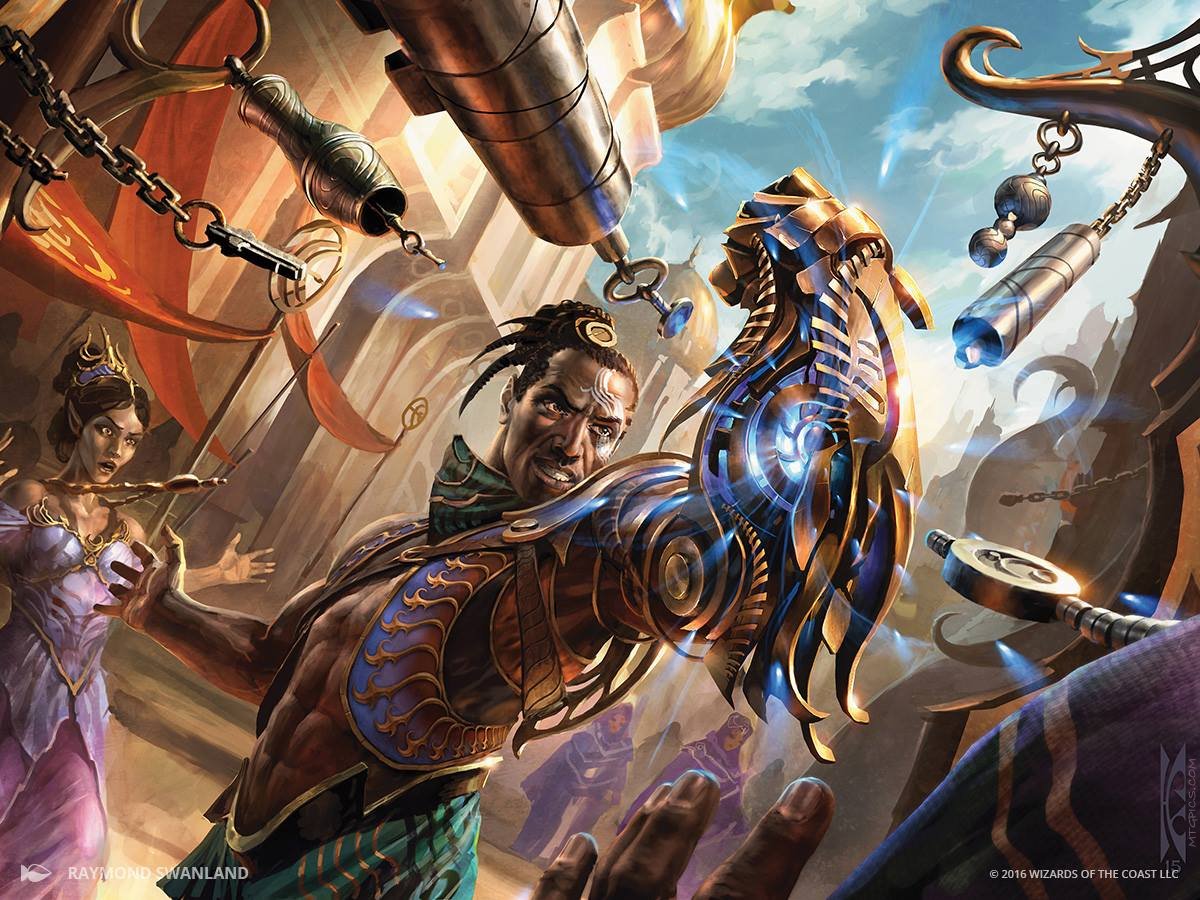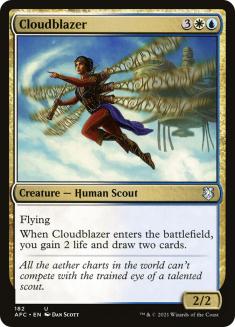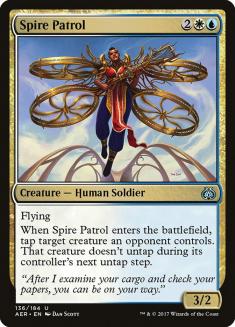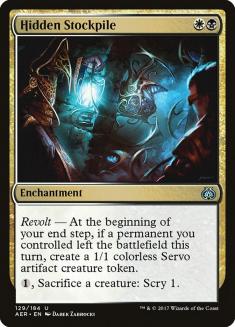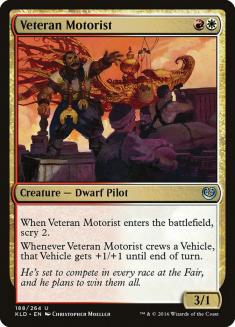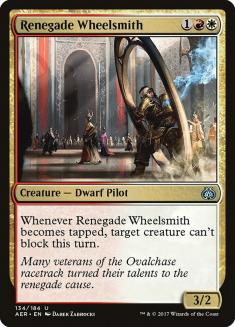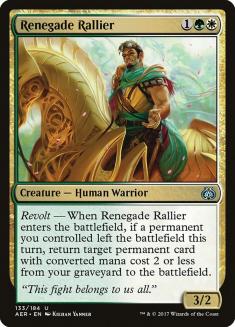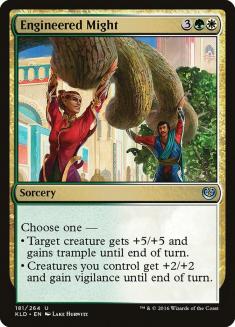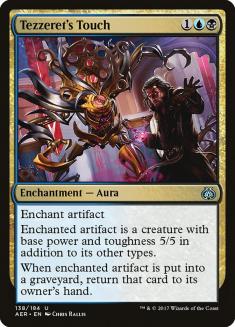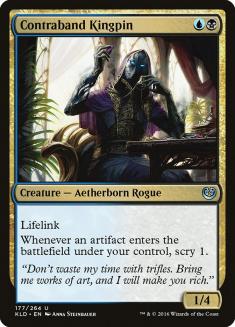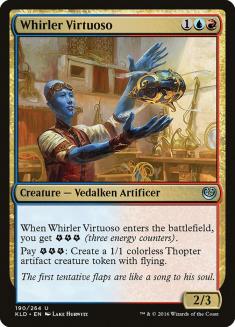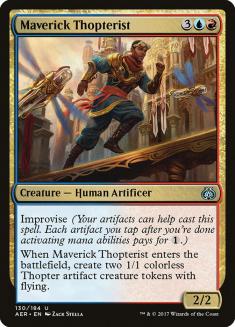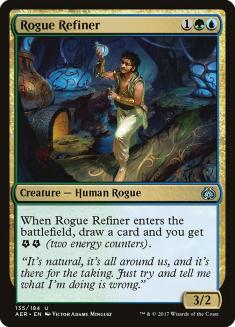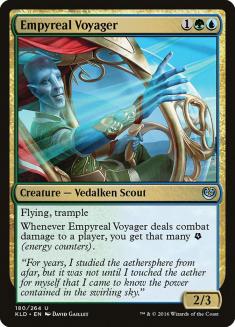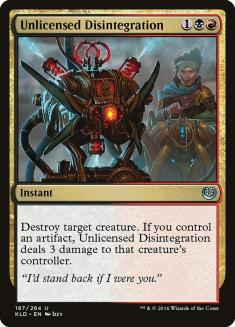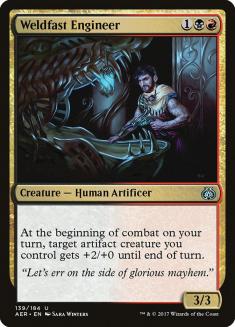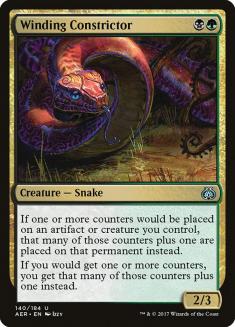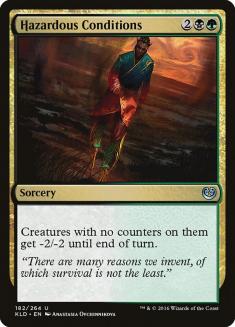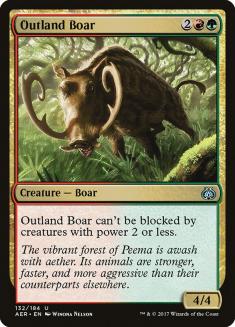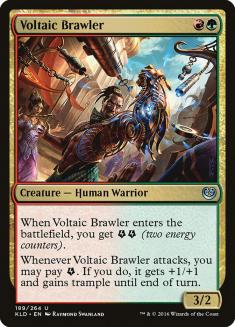Kaladesh Remastered comes to Magic Arena today, and as with most Limited formats, the first few days are where it’s easiest to get the largest edge. A reasonable portion of the player base will not be familiar with the cards, and hence their card evaluations and synergistic understandings will be off. My goal today is to take my experience in the original Kaladesh Block Draft formats, alongside an understanding of what has been added and removed in Kaladesh Remastered, and outline my expectations for the format overall. This includes the best commons, the archetypes, the speed, and all the conclusions that come along with that!
I find the gold uncommons often provide a lot of information on what’s possible for a color combination to do, so let’s start by looking at those. Note that, unlike in most Limited formats, each color combination gets two different uncommons rather than one. There are more uncommons in this format than most, but not double. This means that each color pair has effectively more rewards — the uncommon gold cards — at uncommon. This could theoretically increase the value of staying open, as drafting an uncontested color combination has a higher probability of yielding a gold uncommon. However, this is only true when both gold uncommons are good for the archetype, which is not always true. In that case, the gold uncommon that matters has a lower probability of showing up and hence harms the color pair.
Azorius decks almost always care about flyers. Spire Patrol is a quintessential Azorius card: a great offensive to press advantage and a great defensive play to slow an offending onslaught (and on a great flying body to boot).
Cloudblazer tells a different story, though. The body for the cost is poor, yet drawing two cards and gaining two life skyrockets the power level. For context, both cards are good, but Cloudblazer blows Spire Patrol out of the water.
Overall, Azorius wasn’t really “a deck” in original Kaladesh Block. It was a fine strategy that came together through a suite of strong cards, but not something you were ever seeking out. In fact, Cloudblazer was probably played as a splash in more green decks thanks to Attune with Aether than it was played in Azorius. Looking at the set, I expect this to stay the case.
Both Orzhov gold cards scream that the archetype is all about grinding in the late-game. Hidden Stockpile can do some fun sacrifice things but there’s no Blood Artist to take advantage of that. It’s still an incredibly strong card, as setting up late-game draws, blanking removal, and creating artifact and revolt synergies are all really good things for an Orzhov midrange deck in this format.
And these gold cards even combo together. Sacrificing creatures with Hidden Stockpile to rebuy them with Restoration Gearsmith can be quite powerful. Overall, this bodes very well for Orzhov. The cohesion and raw power of these cards should not be underestimated in what they bring to the archetype.
Surprise, surprise, Boros is an aggressive deck. Both Renegade Wheelsmith and Veteran Motorist are optimized in a deck with Vehicles, and that’s exactly what Boros did in original Kaladesh as well. The plan: come out of the gates early and create value Servo tokens that can be upgraded with Vehicles. Both of those play well to the artifact synergies of the set. Don’t underestimate Salivating Gremlins or Built to Smash in this strategy either. They may not scream Vehicles like these gold cards, but they pack quite the punch.
Selesnya provides the first color combination with a lack of cohesion in the gold cards. Engineered Might asks you to go wide, and Renegade Rallier is just a solid value card. I guess Rallier does help produce a wide battlefield since it sometimes comes with an additional body, but it doesn’t scream “go wide” or “be aggressive” in the same way the Orzhov cards scream “grind.”
This doesn’t bode well for Selesnya. As it’s pretty clear that most archetypes have strong individual cards as their gold cards, and cohesive synergies between them, Selesnya lacking that is a big problem. This means that even if Selesnya is the open strategy, the rewards may not flow as well as for other colors.
Selesnya may be saved by the fact that I love green’s commons, but looking over the white commons, I’m really not sure they pair that well anyway. Poor Selesnya.
Artifacts, artifacts, artifacts! All the Grixis color pairs are all about artifacts. These color pairs were solid in Kaladesh, but they really had their time to shine with Aether Revolt. When you weren’t lucky enough to open Ridgescale Tusker – which, by the way, I am upset was kept as an uncommon, as it’s basically Verdurous Gearhulk – it was reasonable to bias towards the Grixis artifact strategies. Cards like Aether Chaser, Aether Swooper, and Aether Poisoner were so fantastic. They helped push the intersection between green energy strategies and Grixis artifact strategies, so it was easy to take them early and stay open. I expect that to be the same in Kaladesh Remastered.
As far as Dimir is concerned, Contraband Kingpin is an incredibly efficient card that provides significant defensive speed. And Tezzeret’s Touch can end a game all by itself. Both of these cards are fantastic, but not necessarily high picks. Tezzeret’s Touch isn’t going to be a great splash outside of another dedicated artifact deck, and it’s not like Dimir hedges on what Contraband Kingpin provides. The deck is likely still good but I think it’s incredibly important to get a density of good cards. And, unfortunately, blue’s cards look to be a lot more synergy-focused rather than having raw power. It could be difficult for blue to properly support what black needs.
Izzet comes with all the same caveats as Dimir. It’s an intersection of artifact strategies and likely really needs to push for good cards, which blue seems to lack. However, these two gold cards may be the best of the bunch.
Whirler Virtuoso is hard to evaluate at first, but once you see it in action, you won’t pass it often; it’s one of the most explosive energy consumers in the format. Turning energy into a Thopter instead of a +1/+1 counter or a Servo is a very significant upgrade, and one that can be game-winning. Also, it can actually produce infinite Thopters if you’re lucky enough to get a few copies of cards like Decoction Module or other energy engines.
My expectation of what will differentiate Dimir and Izzet is the gold cards. I think it’s possible to just draft Dimir and take good removal and good card advantage. I think red provides a lot less for that strategy than black does. I only really expect to draft Izzet if I get pushed into it by either Whirler Virtuoso or Maverick Thopterist. However, these cards are so powerful that I’ll happily go into the archetype for them.
Rogue Refiner is insane. Two energy isn’t worth quite a full card, but it’s significant value. Empyreal Voyager is good, but not first-pick quality. Overall, Simic is about energy, and the gold cards are a great card and an energy engine.
The only additional complexity with Simic, thanks to Attune with Aether, is the ability to splash. Whirler Virtuoso and Cloudblazer will be common splashes in Simic, so be on the lookout for those!
Unlicensed Disintegration is one of the best Murder variants we’ve ever seen. Murder is already a great card, and this version is splashable and conditionally deals extra damage to boot. I would happily first-pick the card and still play it without artifacts.
Weldfast Engineer, however, is not a good card without artifacts. I’m not sure when this happened but Nessian Courser just isn’t a good card anymore. The last few times we have had a vanilla 3/3 for three, it has been almost always correct to relegate it to the sideboard. This means that Weldfast Engineer really needs a good chunk of artifacts to be worth the inclusions. Luckily for the Engineer, both black and red have a very high density of good artifact creatures and/or cards that make artifact creature tokens, such as Aether Chaser.
I think, together, Engineer and Disintegration showcase an aggressive slant to Rakdos, but they’re not so narrow. A more midrange and/or late-game variant of Rakdos could succeed well with both of those cards; it just wouldn’t leverage them to their best potential. Overall, I like the concept of the aggressively slanted midrange deck with a synergistic component. There should be a lot of play to Rakdos, and many potential avenues to take any Rakdos draft!
Winding Constrictor and Hazardous Conditions form the most polarizing combination of gold cards (even more polarizing than the Selesnya uncommons). Winding Constrictor will be one of the best uncommons in the set, as it’s an above-rate two-drop that completely multiplies the power-level of +1/+1 counter synergies. However, Hazardous Conditions is mostly a sideboard card. Furious Reprisal is one of the most overrated removal spells in the set and that’s because most battlefields don’t contain multiple small threats in this format. Hazardous Conditions will be good against some decks, but I think it’ll be bad against the majority.
Similarly to Selesnya, this doesn’t bode well for Golgari, but Winding Constrictor could save the day. I expect Golgari to be similar to Izzet in the fact that I won’t commonly find myself seeking out the archetype without the marquee gold uncommon, Winding Constrictor.
Gruul does what Gruul does: attack. Outland Boar is quite the boring card (pun intended), but it hits hard and makes every single Gruul Deck. Voltaic Brawler, on the other hand, isn’t boring. It hits just as hard, but the energy can provide other forms of value and it’s two mana cheaper than the Boar. I believe Voltaic Brawler is first-pickable but don’t get confused: Gruul isn’t some energy deck, just an aggressively slanted midrange deck. It has a small energy subtheme, but if Voltaic Brawler isn’t accompanied by other energy producers and consumers, it doesn’t mean the deck is bad.
With an understanding of the archetypes, what does that mean for the format? As far as speed, my expectation is quite in the middle. There are clearly strategies that have a preference for the early-game, and others that have a preference for the late-game. However, an overwhelming majority are neither fast nor slow (classic Limited midrange decks). They can be the aggressor with the right draw, but good creatures, removal, and some card advantage make a fine recipe for success. Don’t skimp on the two-drops though, as there are some openings that really demand battlefield presence to handle.
To end this article, here are my top three commons for each color. Happy drafting!

